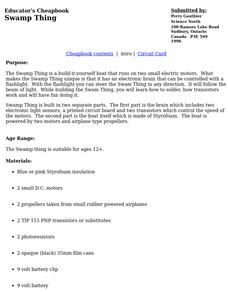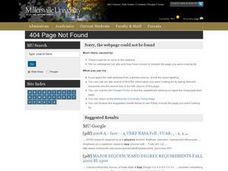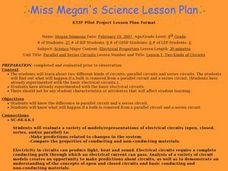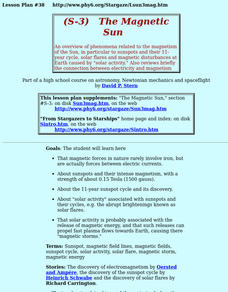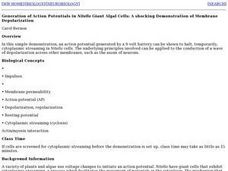Curated OER
Swamp Thing
Students create a build-it-yourself boat that runs on two small electric motors. Swamp Thing has an electronic brain that can be controlled and steered with a flashlight.
Curated OER
Introduction to the Oscilloscope as a Voltmeter
Students measure the electric potential of 9 volt batteries using oscilloscopes. They draw a diagram of the front panel of the oscilloscope, conduct the experiment, and create a graph of voltage versus the number of batteries.
Curated OER
Advantages and Disadvantages of Technology
Students imagine a time when there was no electricity. They work in small groups to list as many inventions as they can and discuss lists and have student groups choose two or three inventions and explore the disadvantages and advantages...
Curated OER
Modeling Breathing Action
Students create a model to identify the parts of the human respiratory system. They explore the Functional Electrical Stimulation (FES) and its use as a breathing support strategy. Students explore reflex actions as an involuntary...
Curated OER
Build an Electrophoresis Chamber
Students explore electrophoresis, a technique used to isolate DNA. They assemble a gel chamber for separating mixtures. Students observe separation influenced by electric charge. They define separation through gel electrophoresis.
Curated OER
New Market
Students use documents from American Memory, plus supplementary material, to investigate electrification as both a technological and a social process. They also identify various ways technology has influenced the course of history. ...
Curated OER
Dam Identification
Students identify and define Hydroelectric dams that provide us with electricity. Then they identify a variety of methods that have been used to try to help salmon make it past the dams on their journey to the sea. Students also become...
Curated OER
A Catering Idea
Students plan meals, create a shopping list, determine the cost of the meal, including incidentals such as labor and electricity used. In addition, they consider the cost of plates, table cloths, napkins, etc. Students prepare a meal and...
Curated OER
Two Kinds of Circuits
Fourth graders examine parallel and series ciruits. They experiment what happens if a bulb is removed from both a parallel and series circuit. They understand the differences between parallel and series ciruits,
Curated OER
Making a Battery
Fifth graders make a battery. In this physical science lesson, 5th graders word in pairs make the battery. Students follow 4 steps to create the battery.
Curated OER
Coal and The Kentucky Economy
Students read about and study what an economy is. Students then answer questions that require them to define what an economy is and list the components of a healthy economy. Students also list two ways that coal helps the Kentucky...
Curated OER
Micro-Magic With Sticky Ions
High schoolers view a video about the formation of precipitates. They complete a worksheet that asks them to identify what makes a compound form and what holds it together.
Curated OER
Middle School Home Energy Audit
Seventh graders research the origins of local electrical power and compare costs and methods of generation with other areas of the country or world.
Curated OER
Energy Sources - Water Wheel Investigation
Pupils create their own water wheel to show the conversion of potential energy to kinetic energy. They discover the production of electricity through hydropower and apply it to different situations. They share any data collected with the...
Curated OER
Indicator Species
Students explore the ecological foundation of India's and ways to save the forests, water and the India tiger. After a lecture on identifying a healthy forest and the importance of the animals, students participate in activities to...
Curated OER
Generation of Action Potentials in Nitella Giant Algal Cells
Students observe cytoplasmic streaming in Nitella cells. They examine the conduction of a wave of depolarization across other membranes, such as the axons of neurons. Students predict the effects of sending a small electric current...
Curated OER
The Electrophoresis of Human Hemoglobin
Students analyze different types of hemoglobin. They use the technique of agarose gel electrophoresis to separate human hemoglobin molecules according to their electrical charge, size, and/or shape. Students relate the migration of...
Curated OER
Hear The Light?
Students investigate a circuit and build a flashlight transmitter. In this electricity lesson, students are introduced to the parts of the modulated laser and define the purpose of each part. As an assessment, students construct a...
Curated OER
A Stroll Down Memory Lane
Young scholars examine the functionality of different types of computer memory (RAM) as a springboard to researching the definitions, uses and functions of different common computer terms. The class creates a computer terminology guide.
Curated OER
Stock Character Lesson Plan
Students examine multiple types of media in order to properly define different types of character that include static, stock, and dynamic characters. They respond to the question of finding someone they respect. They give examples of...
Curated OER
Inventions 1: Edison and the Light Bulb
Young scholars are introduced to the realm and power of inventions, and help them to better recognize their impact on people and society.
Curated OER
Discovering Friction
Students watch a demonstration that introduces them to the idea that friction is a force that impedes motion when two surfaces are in contact. They work in groups to experiment with frictional force using a coffee cup on which they alter...
Other popular searches
- Static Electricity
- Electricity and Magnetism
- Electricity Experiments
- Current Electricity
- Basic Electricity
- Science Static Electricity
- Science Electricity
- Basic Electricity Worksheets
- Electricity and Light Bulb
- Electricity Circuits
- Electricity Magnet
- Electricity Lesson Plans


